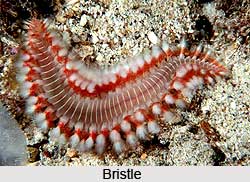 Bristle Worm (Polychaetes) bears segmented bodies, and a distinct head often with tentacles, eyes and other sensory structures. Each segment may bear appendages or feet which have many chaetae (bristles) - hence the name `polychaete` (poly many). They are cosmopolitan in distribution. Indeed, the polychaete fauna of India is very similar to that of the rest of the Indo-Pacific and Australian regions. Their distribution is believed to be regulated mainly by temperature.
Bristle Worm (Polychaetes) bears segmented bodies, and a distinct head often with tentacles, eyes and other sensory structures. Each segment may bear appendages or feet which have many chaetae (bristles) - hence the name `polychaete` (poly many). They are cosmopolitan in distribution. Indeed, the polychaete fauna of India is very similar to that of the rest of the Indo-Pacific and Australian regions. Their distribution is believed to be regulated mainly by temperature.
They could be broadly divided into two major groups; The Errant Worms which are active worms which live in crevices of coral, beneath stones and shells and amongst algae between tide-marks on the shore. They vary in shape from elongate to oval and have uniform paired feet along the length of the body. The feet are mere extensions of the body wall. Nereis is a typical representative and is called the Sea Centipede because of the general resemblance between the body, feet and locomotion of both. Some worms have flattened, over-lapping scale-like structures on their backs which can be raised and lowered to allow a ventilating current to pass over the body.
They are vicious and carnivorous and have powerful jaws at the end of an eversible proboscis which can be shot out to capture a luckless sea creature. Besides eyes, their heads also have other sensory structures. The sexes are separate. The eggs are shed into the water where they are fertilized. The embryo develops into a planktonic larva which is drifted about by the ocean currents. Some worms can reproduce asexually by budding off segments from various points.
Some of the Indian species are found in the Chilka Lake and other fresh or partially brackish waters. The Second category is the sedentary worm which is highly specialized for a sedentary existence. They live in temporary burrows, interconnecting galleries or permanent tubes made of lime, mucous, sand, pieces of coral and sometimes spicules of sponges. Since they are confined to their tubes, they have developed different ways of exploiting water currents for food. Some worms live in permanently fixed tubes; others carry their tubes about with them. Serpula, Sabella and many others are called the Feather-duster or Fan worms as only their heads crowned with tentacles protrude out of their tubes like the corolla of a flower. The tentacles sieve out tiny food particles from the water and these are carried by elaborate ciliated tracts towards the mouth, individual particles being sorted out according to size and shape.
Chaetopterus lives in a U-shaped tube and has a bizarre shape. A pair of its feet is winglike and helps to suspend a mucous net in which food particles are trapped. It creates its own water current by the pumping movements of special semicircular fan-shaped appendages which abut along the sides of the burrow. The mucous net with the trapped food is periodically swallowed shole. Then the worm goes about the process of secreting another mucous trap. Terebella has long tentacles which emerge from the top of the tube and crawl and creep over the ocean floor. Detritus adheres to the mucous on the tentacles and is conveyed in a special groove towards the mouth. These tentacles may even be wiped across the mouth.
These ingenious polychaetes have mastered the art of adaptation. Many of them even have giant nerve fibres which can bring about a very rapid withdrawal reflex, ensuring that the worms have retreated securely into their tubes as soon as the faintest shadow falls over special receptor cells on their tentacles. Another amazing attribute of the polychaetes is their brilliant coloration. The scale-worm Aphrodite has a covering of felt-like hair which displays all the colours of the rainbow in changing light. Many bristle worms are gaily striped and spotted and have brightly coloured gills. Along with sea slugs, they are the equivalent of tropical birds in a rain-forest.






































